
LD51s
INSTRUCTION MANUAL FOR DIGITAL BLOOD PRESSURE MONITOR LD51s
INSTRUKCJA OBSŁUGI CIŚNIENIOMIERZA CYFROWEGO
LD51s
HASZNÁLATI ÚTMUTATÓ.
LD51s
KÉSZÜLÉK A VÉRNYOMÁS ÉS PULZUSSZÁM
DIGITÁLIS MÉRÉSÉRE
MANUAL DE UTILIZARE A TENSIOMETRULUI DIGITAL
LD51s
ІНСТРУКЦІЯ З ЕКСПЛУАТАЦІЇ. ПРИЛАД ДЛЯ ВИМІРЮВАННЯ АРТЕРІАЛЬНОГО
ТИСКУ ТАЧАСТОТИ ПУЛЬСУ ЦИФРОВИЙ
LD51s
fi g.1 rys. 1 1 . ábra desenul 1 мал. 1
PARTS AND COMPONENTS DENUMIREA PĂRŢILOR ȘI COMPONENTELOR
PODSTAWOWE CZĘŚCI I KOMPONENTY
НАЗВАНИЯ НА ЧАСТИ И КОМПОНЕНТИ
ALKATRÉSZEK MEGNEVEZÉSE
EN
HU
RO
PL
UA
EN
NAMES OF PARTS AND COMPONENTS (fi g.1)
8
POWER SUPPLY LD-N057 (INCLUDED).
1
MAIN UNIT.
9
BUTTON M2 (MEMORY 2).
2
LCD DISPLAY.
10
(START/STOP)
BUTTON.
3
CUFF JACK.
11
BUTTON M1 (MEMORY 1).
4
CUFF PLUG.
12
BATTERIES.
5
AIR TUBE.
13
WARRANTY CARD.
6
CUFF.
14
OPERATION MANUAL.
7
POWER SUPPLY ADAPTER JACK.
15
CARRYING BAG.
GENERAL INFORMATION
This manual serves to help the user safely and effi ciently operate the Digital Blood Pressure and Pulse Rate Monitor LD,
model LD51S (hereinafter – the DEVICE). The device shall be used in accordance with the rules given in the manual and
shall not be used for any purposes other than those described herein. Carefully read and understand the entire manual and
the «Recommendations for Correct Measurement» section, in particular.
INDICATIONS FOR USE
The device is designed to measure systolic and diastolic blood pressure and pulse rate in patients aged 15 or older. The
device is recommended for home use by patients with impaired vision, unstable/variable blood pressure or arterial hyper-
tension alongside with medical supervision. The cuff is suitable for the upper arm with a circumference of 25 to 36 cm.
PRINCIPLE OF OPERATION
The device uses the oscillometric method of blood pressure and pulse rate measurement. The cuff is wrapped around the
upper arm and automatically infl ated. The device sensor detects weak cuff pressure fl uctuations, produced by the brachial
artery expansion and contraction in response to each heartbeat. The amplitude of pressure waves is measured, converted
to millimeters of mercury and displayed in the form of a digital value. The device has 2 memory blocks 90 cells per each for
storing the measurement results. Please note that the device may not provide the indicated measurement accuracy if used
or stored at a temperature or humidity other than those specifi ed in the «Specifi cations» section of this manual. Please
consider possible errors when measuring the blood pressure of persons with a severe arrhythmia. Please consult your
doctor when measuring the blood pressure of a child.
RECOMMENDATIONS ON CORRECT MEASUREMENT
1. For correct measurement you should know that THE BLOOD PRESSURE IS SUBJECT TO SHARP VARIATIONS EVEN WITHIN
THE SHORT TIME INTERVALS. The blood pressure depends on many factors. It is usually lower in summer and higher in win-
ter. The blood pressure varies together with the atmospheric pressure, depends on physical loads, emotional excitement,
stresses and dietary regime. Drugs, drinking alcohol and smoking produce signifi cant
Eff ect on blood pressure. Even the very procedure of blood pressure measurement in a hospital sends the blood pressure
high in many people, thus, the blood pressure measured at home often diff ers from the values received in a hospital.
As the blood pressure tends to rise at low temperatures, make measurements at an indoor temperature (approximately
20ºC). If this Device was stored in the room with low temperature, keep it for at least 1 hour at an indoor temperature
before use, otherwise the measurement result may be incorrect. During the day, the diff erence in readings for healthy
people may be 30-50 mmHg of systolic pressure and to 10 mmHg of diastolic pressure. The dependence of the blood
pressure on various factors is individual for each person. Accordingly, it is recommended to keep a special book with blood
pressure measurement records. ONLY A CERTIFIED DOCTOR IS CAPABLE TO ANALYZE THE TENDENCY OF YOUR BLOOD PRES-
SURE VARIATIONS USING YOUR RECORDS.
2. People with cardiovascular and some other diseases requiring blood pressure monitoring should make measurements
in the hours fi xed by attending doctor. REMEMBER THAT THE DIAGNOSTIC AND ANY TREATMENT OF HYPERTENSION MAY BE
CONDUCTED ONLY BY A CERTIFIED DOCTOR ON THE BASIS OF BLOOD PRESSURE VALUES OBTAINED BY THIS DOCTOR. DRUGS
PRESCRIPTION SHOULD BE CARRIED OUT ONLY BY YOUR ATTENDING DOCTOR.
3. At such disorders as deep vascular sclerosis, weak pulse wave and also in patients with the prominent distortions of
cardiac rhythm it may be diffi cult to measure the blood pressure accurately. IN SUCH CASES CONSULT A CERTIFIED DOCTOR
ABOUT APPLICATION OF THE ELECTRONIC DEVICE.
4. KEEP QUIET DURING A MEASUREMENT TO OBTAIN THE ACCURATE VALUES OF YOUR BLOOD PRESSURE WITH THE ELEC-
TRONIC DEVICE. Measure your blood pressure in the calm and comfortable conditions at the indoor temperature. No eating
an hour before measurement; no smoking, no taking tonic agents or alcohol 1.5-2 hours before measurement.
5. The accuracy of blood pressure measurement depends on whether the cuff matches the size of your arm. THE CUFF
SHOULD NOT BE TOO SMALL OR TOO LARGE.
6. Wait 3 minutes between measurements for the blood to restore its circulation. However, the persons with prominent
atherosclerosis due to considerable loss of vascular elasticity may need to increase the wait time between measurements
(10-15 minutes). This also refers to the patients suff ering from diabetes. For more accurate determination of blood pres-
sure, it is recommended to make a series of 3 consecutive measurements and to use the average value.
INSTALLING BATTERIES (fi g. 2)
1. Open the cover of the battery compartment and install 4 “AA” size batteries according to polarity marked inside the
compartment. Do not use much force to remove the cover of the battery compartment.
2. Close the battery cover.
Replace all batteries when the Low Battery Indicator “
”, appears on the screen or when there is no indication on the
screen. The Low Battery Indicator does not show the discharge level. It is recommended to use alkaline batteries. If the
Device operation rules are observed, the batteries will last for approximately 1,000 measurements.
The batteries supplied with the Device are intended for check of the Device performance at sale and their service life may
be shorter than of the recom mended batteries.
Replace all four batteries at the same time. Do not use the waste batteries.
If the Device is unused for a long time, remove all batteries.
Do not leave the waste batteries in the Device.
CORRECT POSE DURING MEASUREMENT (fi g. 3)
1. Sit near a table so that your arm rests on its surface during measurement. Make sure that the point of the cuff applica-
tion is approximately at the same height as your heart, and that your forearm lies freely on the table and does not move.
2. You can measure pressure when lying on your back. Look at the ceiling, keep calm and do not move during measure-
ment. Make sure that the measurement point on your upper arm is approximately at the same level as your heart.
CUFF PREPARATION (fi g. 4)
1. Insert the cuff end for about 5 cm into a metal ring as shown in fi gure.
2. Apply the cuff to your left upper arm so that the air tube is directed to your palm. If the measurement on your left arm
is diffi cult, you may use your right arm. In this case remember that the readings may diff er by 5-10 mmHg and even more.
3. Wrap the cuff around your upper arm so that the bottom of the cuff is approximately 2-3 cm above your elbow. The sign
“ARTERY” should be over the arm artery.
4. Fix the cuff so that it fi ts tightly to the arm, but make sure that it is not overtight. Too tight or too loosen placement of
the cuff may give inaccurate readings.
5. On the fi xed cuff the sign «INDEX» should point to the area «NORMAL (25-36 cm)».It means that the cuff is chosen cor-
rectly and fi ts the size of your upper arm. if the sign points to the area marked «
» the cuff is too small and the readings
will be higher. If the sign points to the area marked «
» the cuff is too large and the readings will be lower.
6. If the arm has a conic form, the cuff should be put on with a spiral movement as shown in the fi gure.
res not corresponding to your actual blood pressure.
MEASUREMENT PROCEDURE (fi g. 5)
The device has a voice annunciation function «VS», so presetting is required prior to using: the voice system volume level
and language need to be selected.
VOICE SYSTEM VOLUME LEVEL SETTING
To set the volume level on the powered-off device, press and hold M1 button and, at the same time, press the button
once. The “
”symbol fl ashes on the display. Press M1 button to select the desired volume level.
The voice annunciation level is displayed with the following symbols:
– the voice annunciation is disabled;
– minimum volume level;
– medium volume level;
– maximum volume level.
Press the button
to fi nish the voice annunciation volume setting.
VOICE ANNUNCIATION LANGUAGE SETTING
To set the voice annunciation language on the powered off device press and hold M1 button and, at the same time, press
the
button twice. «L» symbol appears on the display. Press M1 button to select the desired language.
The voice annunciation language is displayed with the following symbols:
L1 – Polish; L4 – Russian;
L2 – Hungarian; L5 – Ukrainian.
L3 – Romanian;
Press the button
to fi nish the voice annunciation language setting. Polish language set by default.
BLOOD PRESSURE MEASUREMENT PROCEDURE
1. Insert the cuff plug into the cuff jack. Before taking a measurement do 3-5 deep breaths and relax. Do not move, talk or
tense your arm during the measurement.
2. Press the button
.
3. All the symbols will be displayed briefl y (Fig. 5.1). You will hear a voice message about the measurement start. The device
will automatically start air infl ation into the cuff . The infl ation will initially stop at 190 mm Hg (Fig. 5.2).
4. Upon reaching 190 mm Hg, the cuff pressure will gradually decrease. The values displayed will start to decrease. The
pulse is indicated by fl ashing “
” symbol. SINCE THE BLOOD PRESSURE AND PULSE RATE ARE MEASURED DURING THE CUFF
DEFLATION, PLEASE REMAIN STILL AND NEITHER MOVE YOUR HAND NOR TENSE THE MUSCLE DURING THE MEASUREMENT.
5. At the end of measurement the device will defl ate the cuff and display the measurement results (Fig. 5.3) duplicated
by a voice message. M1/M2 symbols will start to fl ash, reminding to save the results to memory 1 or 2 by pressing M1 or
M2 button respectively. If the memory is not selected within 3 minutes, the results will not be saved and the device will
automatically turn off .
6. Press the
button to turn it off . TO OBTAIN ACCURATE RESULTS, THE BREAK BETWEEN THE MEASUREMENTS IS NEEDED TO
RESTORE THE BLOOD CIRCULATION. MEMORY DATA WILL BE SAVED EVEN WITH THE DEVICE STORED WITHOUT THE BATTERIES.
SAVED DATA CAN BE DELETED FROM THE DEVICE MEMORY BY FOLLOWING THE ACTIONS DESCRIBED IN THE «MEMORY FUNC-
TION» SECTION. If no action is taken within 3 minutes after measurement, the device will automatically turn off .
MEMORY FUNCTION (fi g. 6)
1. Each measurement results (pressure and pulse) can be saved to the device memory. To do this, once the measurement
completed, within no more than 3 minutes, you need to select memory M1 or M2 for saving.
THE MEASUREMENT RESULTS WILL NOT BE SAVED IN CASE OF ERROR MESSAGE DISPLAYED.
2. Each memory block can store up to 90 measurement results and the average value of the last 3 measurements. When the
number of measurements exceeds 90, the oldest record is automatically deleted to save the most recent measurement values.
3. You can view the memory contents by pressing M1 or M2 button. When M1 (or M2) button is pressed for the fi rst time,
the average value of the last 3 measurements stored in M1 (or M2), indicated by «A» symbol (Fig. 6.1), will be displayed.
When M1 (or M2) button is pressed again, the indicator of the selected memory M1 (or M2) and the cell number will be
displayed, showing its contents (Fig. 6.2) duplicated by a voice message 1 second later. Each press of M1 (or M2) button
takes you to the next memory cell.
DEVICE MEMORY CLEARING
To delete all saved measurement results from M1 (or M2) memory, press and hold M1 (or M2) button for more than 3
seconds. «Clr» symbol will be displayed and the selected memory will be cleared.
ERROR MESSAGES
INDICA-
TION
POSSIBLE CAUSE SOLUTION
REMEDY
The cuff is put on incorrectly or the air tube tee
connector is inserted loosely.
Make sure the cuff is put on correctly, and the tee is in-
serted tightly, and repeat the measurement procedure.
Measurements could not be done because of the
arm movement or talking during measurement.
The cuff was not pumped to the required level.
In case of apparent heart rhythm disorders, deep
vascular sclerosis, weak pulse wave, correct mea-
surement of blood pressure may be hindered.
Repeat the measurement with full observation of the
recommendations of this operation manual.
Repeat the measurement, pumping the cuff 30-40 mm
Hg higher than the expected systolic pressure.
In these cases, you should consult a certifi ed physician
about the use of the electronic Device.
Batteries are discharged Replace all batteries with new ones
CARE, STORAGE, REPAIR AND DISPOSAL
1. This Device should be protected from increased humidity, direct sunrays, impact, vibration. THE DEVICE IS NOT WATER-
PROOF!
2. Do not store and do not use the Device in close proximity to heating Devices and open fi re.
3. If the Device is not used for a long time, remove the batteries from the Device. Battery leakage may damage the Device.
KEEP THE BATTERIES AWAY FROM CHILDREN!
4. Do not contaminate the Device and protect it from dust. You can use soft dry cloth to clean the Device.
5. Avoid contact of the Device or its parts with water, solvents, alcohol. Do not use petroleum.
6. Protect the cuff from sharp object, and do not try stretching or twisting the cuff .
7. Do not expose the Device to strong impacts and do not drop it.
8. The Device does not have any measurement accuracy controls. Individual disclosure of the electronic unit is prohibited.
If necessary, the repair shall be performed only in specialized organizations.
9. After the end of the established service life you should periodically contact experts (specialized repair organizations) to
check the technical condition of the Device.
10. Disposal is governed by the rules in eff ect in your region. The manufacturer does not establish any special disposal
conditions for this Device.
11. The cuff is resistant to repeated sanitary treatment. It is allowed to treat the inner side of the cloth surface of the cuff
(the one contacting with the patient’s arm) with a cotton wool pad damped in 3 % hydrogen peroxide solution. In case of
continuous use, partial decoloring of the cloth surface of the cuff is admissible. Wet wash of the cuff , as well as its treatment
with a hot iron, is not allowed.
POTENTIAL PROBLEMS
PROBLEM PROBABLE CAUSE METHOD OF CORRECTION
No indication on the
display
Worn batteries.
The battery polarities do not match.
Dirty battery contacts.
Power supply is not plugged in.
Replace all batteries for new ones.
Install batteries correctly.
Clean the terminals with dry cloth.
Plug the power source into an electrical outlet.
Infl ation stops
and resumes.
Automatic infl ation occurs to ensure correct
measurements.
Perhaps you were talking or moving your arm
during the measurement?
See MEASUREMENT PROCEDURE.
Calm down and repeat the measurement.
Diff erent blood
pressure every time.
Measurement values are
too low (high).
Is the cuff on the same level as your heart?
Is the cuff positioned correctly?
Is your arm tense?
Perhaps you were talking or moving your arm
during the measurement.
Take the correct position for measurement.
Put on the cuff correctly.
Calm down, apply the arm cuff correctly.
Keep silence and quiet during measurement.
Pulse rate is too high
(too low).
Perhaps you were talking or moving your arm
during the measurement.
Were the measurements taken immediately
after exercise?
Keep silence and quiet during measurement.
Repeat the measurement at least in 5 min.
Impossible to take
multiple measurements.
Use of defective
batteries.
Use only alkali batteries of well-known
manufacturers.
No voice annunciation. Voice mode disabled. Set the voice annunciation level (See
MEASUREMENT PROCEDURE).
TECHNICAL SPECIFICATIONS
Measurement method oscillometric
Indicator
liquid crystal
Pressure indication range in an arm cuff , mmHg from 0 to 300
Measurement range:
pressure in an arm cuff , mmHg
pulse rate, 1/min
from 40 to 260
from 40 to 160
Range of admissible absolute error at measurement of air
pressure in an arm cuff , mmHg ±3
Range of admissible relative error at pulse rate
measurement, % ±5
Infl ation
automatic (air pump)
Defl ation
automatic
Memory 2х90 measurements + average of the last 3 measurements per each
memory block
Power supply voltage, V
6
Type of power supply
4 AA batteries (LR6) or power supply, 600 mA min.
Max. power consumption, W
3,6
Voltage limit values, V
from
4,5 до 6
Power supply LD-N057 (included)
Output voltage, V
Maximum load current
Input voltage
Dimensions
Weight
Cord length
Plug:
Polarity of the contacts
Inner diameter, mm
Outer diameter, mm
Plug contact length, mm
6 ± 5%
1.0 А
~100-240 V, 50/60 Hz
64 x 70 x 43 mm
85 g max.
1500 ± 50 mm
«–» internal
2.1 ± 0.1
5.5 ± 0.1
10 ± 0.5
Operation conditions:
Temperature, °C
Relative humidity, % Rh
from 10 to 40
85
and lower
Storage and transportation conditions:
Temperature, °C
Relative humidity, % Rh
from -20 to 50
85
and lower
Voice annunciation languages
Polish, Hungarian, Romanian, Russian, Ukrainian
Cuff size: larger for adults (upper arm circumference 25-36 cm)
Dimensions:
Size (electronic block), mm
Weight (without package, case, batteries and adapter), g
129 x 105 x 61
433
Complete set
Main unit, Cuff -LDA, 4 AA (LR6) Batteries, Power supply LD-N057,
Carrying Bag, Warranty Card, Instruction Manual.
The year and month of production
The year and month of production are included in the serial number after
«A» symbol. The serial number is located on the bottom of the device.
SYMBOL EXPLANATION:
Compliance with the Directive 93/42/EEC
Important: Read the instruction
Representative in the EU
Manufacturer
Ukraine conformance mark
Approval of means of measurement types of Ukraine
Keep from moisture
Protection class II
BF type product
The revision date of this Operation manual is indicated at the last page in the EXXX/YYMM/NN format, where YY is the year,
ММ is the month, and NN is the revision number. Technical specifi cations are subject to change without prior notice in order
to improve operational properties and quality of the product.
Production is certifi ed according to the international standard ISO 13485. The LD51s Device complies with the European Direc-
tive MDD 93/42/ЕЕС, international standards EN980, EN1041, EN1060-1, EN1060-3, EN10601-1-2, ISO 14971.
WARRANTY
The warranty liabilities are contained in the warranty card given at the sale of this Device to a purchaser.
The addresses of organizations for warranty maintenance are given in the warranty card.
Manufactured under control and for Little Doctor International (S) Pte. Ltd. (35 Selegie Road #09-02 Parklane Shopping Mall,
Singapore 188307, postal address: Yishun Central P.O. Box 9293 Singapore 917699).
Manufacturer: Little Doctor Electronic (Nantong) Co., Ltd., (No. 8, Tongxing Road Economic & Technical Development Area,
226010 Nantong, Jiangsu, People’s Republic of China).
Distributor in European Union: Little Doctor Europe Sp. z o. o. (57G Zawila Street, 30-390 Kraków, Poland, phone: +48 12
2684746, 12 2684747, fax: +48 12 268 47 53, e-mail: biuro@littledoctor.pl)
For more information please visit www.littledoctor.sg
PL
NAZWA CZĘŚCI I ELEMENTÓW (rys.1)
8
STABILIZOWANY ZASILACZ LD-N057
(DOŁĄCZONY DO KOMPLETU).
1
BLOK ELEKTRONICZNY.
9
PRZYCISK M2 (PAMIĘĆ 2).
2
WYŚWIETLACZ CIEKŁOKRYSTALICZNY.
10
PRZYCISK
(START/STOP).
3
GNIAZDO DO PODŁĄCZANIA MANKIETU.
11
PRZYCISK M1 (PAMIĘĆ 1).
4
WTYCZKA MANKIETU.
12
BATERIE.
5
PRZEWÓD POWIETRZA.
13
KARTA GWARANCYJNA.
6
MANKIET.
14
INSTRUKCJA OBSŁUGI.
7
GNIAZDO DO PODŁĄCZANIA ZASILANIA ELEKTRYCZNEGO.
15
ETUI.
INFORMACJE OGÓLNE
Niniejsza instrukcja ma pomóc użytkownikowi w bezpiecznym i efektywnym posługiwaniu się urządzeniem do pomiaru
ciśnienia tętniczego krwi LD, szczególnie LD51S (dalej w tekście: URZĄDZENIE). Powinno ono być stosowane zgodnie z
zasadami przedstawionymi w niniejszej instrukcji i nie należy go wykorzystywać do celów innych niż tu opisane. Należy
przeczytać i zrozumieć całą instrukcję obsługi, zwłaszcza rozdział “Zalecenia dotyczące prawidłowego pomiaru”.
ZASTOSOWANIE
Urządzenie przeznaczone jest do pomiaru skurczowego i rozkurczowego ciśnienia tętniczego krwi oraz pulsu u pacjentów
w wieku od 15 lat wzwyż. Ciśnieniomierz zalecany jest do stosowania u pacjentów z niestabilnym ciśnieniem tętniczym
lub nadciśnieniem tętniczym w warunkach domowych jako uzupełnienie nadzoru lekarskiego. Mankiet dostosowany jest
do ramion o obwodzie 25-36 cm.
ZASADA DZIAŁANIA
Urządzenie wykorzystuje oscylometryczną metodę pomiaru ciśnienia tętniczego krwi. Mankiet jest owijany wokół ramienia i
pompowany automatycznie. Czujnik wychwytuje delikatne wahania zmiany ciśnienia w mankiecie, powodowane rozszerzaniem
się i kurczeniem się tętnicy ramiennej odpowiednio do bicia serca. Mierzona amplituda fal ciśnienia przekładana jest na wartość
wysokości słupa rtęci, wyświetlaną na wyświetlaczu LCD. Urządzenie posiada 2 pamięci po 90 komórek do przechowywania
wyników pomiarów. Należy pamiętać, że aby urządzenie wyświetlało poprawne wyniki, musi ono być przechowywane i
wykorzystywane w temperaturach i przy wilgotności, nie odbiegających od opisanych w dziale ”Specyfi kacja techniczna” danej
instrukcji. Uprzedzamy o możliwości przekłamania pomiarów u osób z rozrusznikami serca, arytmią serca, zwężeniem naczyń,
zaburzeniami wątroby i cukrzycą. Przed pomiarem ciśnienia u dzieci wskazane jest skonsultowanie się z lekarzem.
ZALECENIA DOTYCZĄCE PRAWIDŁOWEGO POMIARU
1. Dla przeprowadzenia prawidłowego pomiaru należy pamiętać, że CIŚNIENIE TĘTNICZE PODLEGA SILNYM WAHANIOM
NAWET W KRÓTKIM OKRESIE CZASU. Poziom ciśnienia krwi zależy od wielu czynników. Zwykle jest ono niższe latem i
wyższe zimą. Ciśnienie krwi zmienia się wraz z ciśnieniem atmosferycznym, zależy od wysiłku fi zycznego, emocjonalnej
pobudliwości, stresu, diety. Duży wpływ mają używki, narkotyki, alkohol i palenie tytoniu. U wielu osόb nawet procedura
pomiaru ciśnienia w przychodni powoduje wzrost wskaźników. Dlatego ciśnienie tętnicze zmierzone w warunkach do-
mowych może różnić się od ciśnienia mierzonego w klinice. W związku z tym, że ciśnienie krwi wzrasta w niskich temperat-
urach, przeprowadzać jego pomiar trzeba w temperaturze pokojowej (około 20 °C). Jeżeli urządzenie było przechowywane
w niskiej temperaturze, zaleca się pozostawić go w temperaturze pokojowej przez co najmniej 1 godzinę. Po tym czasie
można korzystać z tego urządzenia. W przeciwnym wypadku wynik pomiaru ciśnienia może być błędny. W ciągu doby
różnica we wskazaniach zdrowych ludzi może wynosić 30-50 mm Hg. ciśnienia skurczowego (górnego) i do 10 mm Hg.
ciśnienia rozkurczowego (dolnego). U każdego człowieka ciśnienie zależy od różnych czynników. Dlatego zaleca się prow-
adzenie dziennika pomiarów ciśnienia tętniczego krwi. TYLKO DYPLOMOWANY LEKARZ NA PODSTAWIE TAKICH DANYCH
MOŻE ANALIZOWAĆ TENDENCJE ZMIAN CIŚNIENIA TĘTNICZEGO.
2. Przy chorobach sercowo–naczyniowych i w przypadku wielu innych chorób, które wymagają monitorowania
ciśnienia tętniczego, pomiary należy wykonywać w porach, wskazanych przez lekarza. PAMIĘTAJ, ŻE DIAGNOSTYKA I
JAKIEKOLWIEK LECZENIE NADCIŚNIENIA TĘTNICZEGO MOŻE BYĆ WYKONYWANE TYLKO PRZEZ LEKARZA NA PODSTAWIE
JEGO WŁASNORĘCZNĘGO ODCZYTU POMIARÓW CIŚNIENIA KRWI. PRZYJMOWANIE LUB ZMIANĘ DAWEK LEKÓW NALEŻY
PRZEPROWADZAĆ TYLKO WEDŁUG ZALECEŃ LEKARZA.
3. Pomiar ciśnienia tętniczego może być utrudniony przy takich zaburzeniach jak: miażdżyca naczyń krwionośnych, słaba
fala pulsu, a także u pacjentów z poważnymi zaburzeniami rytmu serca,. W TYCH PRZYPADKACH NALEŻY SKONSULTOWAĆ
SIĘ Z DYPLOMOWANYM LEKARZEM ODNOŚNIE STOSOWANIA URZĄDZENIA ELEKTRONICZNEGO.
4. W TRAKCIE POMIARU PRZY KORZYSTANIU Z ELEKTRONICZNEGO URZĄDZENIA DLA UZYSKANIA PRAWIDŁOWEGO OD-
CZYTU CIŚNIENIA TĘTNICZEGO NALEŻY ZACHOWAĆ CISZĘ . Pomiar ciśnienia tętniczego powinien być przeprowadzony w
spokojnej atmosferze przy temperaturze pokojowej. Godzinę przed wykonaniem pomiaru ciśnienia należy unikać jedzenia,
picia 1,5-2 godziny palenia papierosów, spożywania napojów tonizujących lub alkoholu.
5. Dokładność pomiaru zależy od dopasowania mankietu urządzenia do wielkości ręki. MANKIET NIE POWINIEN BYĆ ZBYT
MAŁY LUB ZBYT DUŻY.
6. W celu przywrócenia prawidłowego ciśnienia krwi, ponowne pomiary winny być wykonywane w odstępach 3 minut.
Jednak dla osόb cierpiących na miażdżycę, z powodu dużej utraty elastyczności naczyń krwionośnych, między pomiarami
wymagany jest większy odstęp czasu (10-15 minut). Dotyczy to również pacjentów z cukrzycą. Aby dokładniej określić
ciśnienie krwi, zaleca się wykonać serię 3 kolejnych pomiarów i wykorzystać średnią wartość wyników pomiaru.
INSTALACJA BATERII (rys. 2)
1. Otwórz pokrywę komory baterii i włóż 4 baterie AA, jak pokazano na schemacie, który znajduje się wewnątrz tej ko-
mory. Upewnij się, że polaryzacja jest przestrzegana. Podczas otwierania pokrywy komory baterii prosimy nie stosować
nadmiernej siły.
2. Zamknij pokrywę komory baterii.
W przypadku gdy na wyświetlaczu ciągle jest widoczny symbol wymiany baterii “
” lub na nim nic się nie wyświetla
należy wymienić wszystkie elementy zasilania. Wskaźnik wymiany baterii nie pokazuje stopnia rozładowania. Zaleca się
stosowanie baterii alkalicznych. Przy zachowaniu zasad obsługi urządzenia baterie wytrzymują około 1000 pomiarów.
Przy wymianie baterii należy wymienić je wszystkie jednocześnie. Nie należy korzystać z baterii, które były w użyciu. Jeśli
urządzenie nie jest używane przez dłuższy czas, należy wyjąć z niego baterie.
Nie należy zostawiać zużytych baterii w urządzeniu.
PRAWIDŁOWA POSTAWA PODCZAS POMIARU (rys. 3)
1. Usiądź tak, aby podczas pomiaru ciśnienia krwi Twoja ręka leżała na powierzchni stołu. Upewnij się, że miejsce założenia
mankietu znajduje się na tej samej wysokości co serce, że przedramię swobodnie leży na stole i nie rusza się.
2. Można mierzyć ciśnienie i w pozycji leżącej na plecach. Patrząc na sufi t, zachowaj spokój i nie ruszaj się w trakcie
pomiaru. Upewnij się, że miejsce pomiaru na ramieniu znajduje się na poziomie serca.
PRZYGOTOWANIE MANKIETU (rys. 4)
1. Wsuń krawędź mankietu w metalowy pierścień na około 5 cm, jak pokazano na rysunku.
2. Załóż mankiet na lewą rękę, rurka powinna być skierowana w stronę dłoni. W przypadku gdy pomiar na lewej ręce jest
utrudniony, można przeprowadzić pomiar na prawej ręce. W tym przypadku należy pamiętać, że wyniki mogą się różnić o
5-10 mm hg.
3. Owinąć mankiet wokół ramienia tak, aby dolna krawędź mankietu znajdowała się w odległości 2-3 cm od zgięcia
łokciowego. Etykieta z napisem “ARTERY” powinny znajdować się nad tętnicą.
4. Zapiąć mankiet tak, aby ciasno przylegał do ramienia, ale go nie ściskał. Zbyt ciasne lub odwrotnie, zbyt luźne umieszc-
zenie mankietu może prowadzić do niedokładnych odczytów.
5. Na zapiętym mankiecie znaczek “INDEX” powinien wskazywać na obszar “NORMALNY (25-36 cm)”. Oznacza to, że
mankiet jest dopasowany prawidłowo i odpowiada rozmiarowi obwodu ramienia. Jeżeli strzałka wskazuje na obszar “
”, oznacza to, że mankiet jest za mały i wyniki będą zawyżone. Jeżeli strzałka wskazuje na obszar “ ” oznacza to, że
mankiet jest za duży i wyniki będą zaniżone.
6. W przypadku, gdy ręka ma wyrażoną stożkowatość, zaleca się spiralne zakładanie mankietu, jak pokazano na rysunku.
7. Podwinięte rękawy nie mogą uciskać ramienia, gdyż może to zmniejszyć przepływ krwi, a odczyty urządzenia mogą
być nieprawidłowe.
PROCEDURA POMIARU (rys. 5)
Urządzenie posiada funkcję głosowego powiadamiania „VS”, przed jego użyciem należy dokonać wstępnych ustawień:
wybrać poziom głośności oraz język komunikatów głosowych.
USTAWIENIE POZIOMU GŁOŚNOŚCI KOMUNIKATÓW:
Na wyłączonym urządzeniu, trzymając wciśnięty przycisk M1, naciśnij przycis
(power). Na ekranie pojawi się symbol «
» . Wciśnij przycisk M1 i wybierz odpowiedni dla Ciebie poziom głośności.
Jego poziom oznaczają odpowiednio:
– dźwięk wyłączony;
– minimalny poziom głośności;
– średni poziom głośności;
– maksymalny poziom głośności.
Aby zakończyć etap ustawiania poziomu głośności wciśnij
.
USTAWIANIE JĘZYKA KOMUNIKATÓW
Aby ustawić język komunikatów, na wyłączonym urządzeniu trzymaj wciśnięty przycisk М1, i naciśnij dwukrotnie przycisk
(power). Na ekranie pojawi się symbol „L”.
Za pomocą przycisku М1 wybierz właściwy język, ustalając odpowiedni symbol:
L1 – polski; L4 – rosyjski;
L2 – węgierski; L5 – ukraiński.
L3 – rumuński;
Aby zakończyć etap ustawiania wyboru języka wciśnij
W ustawieniu fabrycznym urządzenie nastawione jest na język polski.
PROCEDURA POMIARU CIŚNIENIA TĘTNICZEGO (rys. 5)
1. Podłącz złącze mankietu do właściwego gniazda ciśnieniomierza. Przed pomiarem rozluźnij się i weź 3-5 głębokich
oddechów. Nie poruszaj się, nie naprężaj ręki i nic nie mów w czasie pomiaru.
2. Naciśnij przycisk
.
3. Przez moment na wyświetlaczu zostaną podświetlone wszystkie znaki (rys. 5.1), usłyszysz krótki sygnał i urządzenie
automatycznie zacznie pompować mankiet. Pierwsze pompowanie mankietu zatrzyma się na poziomie 190 mmHg
(rys.5.2).
4. Po osiągnięciu wartości 190 mmHg ciśnienie w mankiecie zacznie stopniowo spadać, a wyświetlana wartość będzie
malała. Puls oznaczony jest migającym symbolem «
». Z UWAGI NA TO, ŻE CIŚNIENIE TĘTNICZE I PULS MIERZONE SĄ
PODCZAS UWALNIANIA POWIETRZA Z MANKIETU, STARAJ SIĘ NIE PORUSZAĆ RĘKĄ I NIE OBCIĄŻAĆ RAMIENIA.
5. Na koniec pomiaru urządzenie wypuści z mankietu całe powietrze, a na wyświetlaczu pojawi się wynik pomiaru
ciśnienia skurczowego, ciśnienia rozkurczowego i pulsu (rys. 5.3) oraz komunikat głosowy (odczyt wyniku). Migający znak
M1/M2 przypomina, że w celu zapisania wyników należy wybrać pamięć 1 lub 2, naciskając odpowiednio M1 lub M2. Jeżeli
w ciągu 3 minut nie dokonasz wyboru, urządzenie wyłączy się automatycznie bez zapisywania wyniku.
6. Wyłącz urządzenie. W celu powtórnego przeprowadzenia pomiaru powtórz od początku wszystkie działania opisane
w danym rozdziale instrukcji. W CELU OTRZYMANIA DOKŁADNYCH WYNIKÓW NALEŻY ROBIĆ PRZERWY MIĘDZY POMIAR-
AMI, ABY PRZYWRÓCIĆ KRĄŻENIE KRWI. DLATEGO POWTÓRNY POMIAR ZALECA SIĘ PRZEPROWADZAĆ NIE WCZEŚNIEJ NIŻ
PO KILKU MINUTACH OD ZAKOŃCZENIA POPRZEDNIEGO POMIARU. DANE Z POMIARÓW PRZECHOWYWANE SĄ W PAMIĘCI
CIŚNIENIOMIERZA NAWET PO WYJĘCIU BATERII Z URZĄDZENIA.SPOSÓB ICH USUWANIA ZNAJDZIESZ W ROZDZIALE „FUNKCJA
PAMIĘCI”. Urządzenie wyłączy się automatycznie po upływie 3 minut, o ile nie nastąpią inne działania.
POMPOWANIE AUTOMATYCZNE
Jeżeli początkowe pompowanie mankietu do wartości 190 mmHg nie jest wystarczające lub zostanie wykonany ruch ręką,
urządzenie napompuje mankiet do wyższej wartości. Ciśnieniomierz posiada 4 stałe poziomy pompowania mankietu:
190, 230, 270, 300 mmHg. Automatyczne pompowanie mankietu jest powtarzane, dopóki pomiar nie zakończy się pow-
odzeniem. Nie oznacza to wady urządzenia.
WYMUSZONE SPUSZCZANIE POWIETRZA Z MANKIETU
Jeżeli podczas pompowania mankietu lub podczas pomiaru (w trakcie powolnego spuszczania powietrza) zajdzie potrzeba
szybkiego spuszczenia powietrzna, należy wcisnąć przycisk
. Urządzenie szybko wypuści resztę powietrza z mankietu i
wyłączy się.
FUNKCJA PAMIĘCI (rys. 6)
1. Wynik każdego pomiaru (ciśnienie i puls) można zapisać w pamięci urządzenia. W tym celu należy w ciągu 3 minut po
zakończeniu pomiaru wybrać pamięć M1 lub M2. WYNIK POMIARU NIE ZOSTANIE ZAPISANY W PRZYPADKU POJAWIENIA SIĘ
POWIADOMIENIA O BŁĘDZIE.
2. W każdej z pamięci urządzenia można zapisać maksymalnie 90 wyników pomiarów oraz średnią wartość ostatnich 3
wyników. Gdy liczba zapisanych pomiarów przewyższy 90, najstarsze dane są automatycznie zamieniane wynikami kole-
jnych pomiarów.
3. Zawartość pamięci urządzenia można przejrzeć, naciskając przycisk M1 lub M2. Po pierwszym naciśnięciu przycisku M1
(lub М2) na wyświetlaczu pojawi się średnia wartość 3 ostatnich pomiarów, zapisanych w pamięci M1 (lub М2) oznaczona
symbolem „A” (rys. 6.1). Po powtórnym naciśnięciu przycisku M1 (lub M2) na wyświetlaczu pojawi się wskaźnik wybranej
pamięci M1 (lub М2) i numer komórki pamięci, a po upływie 1 sekundy wyświetli się jej zawartość (rys. 6.2) oraz zostanie
odczytany komunikat głosowy. Każde naciśnięcie przycisku M1 (lub M2) powoduje przejście do kolejnej komórki pamięci.
CZYSZCZENIE PAMIĘCI URZĄDZENIA
Aby usunąć wszystkie wyniki, przechowywane w pamięci urządzenia M1 (lub M2), należy nacisnąć przycisk M1(lub M2) i
przytrzymać go przez ponad 3 sekundy. Na wyświetlaczu pojawi się symbol “Clr”, co oznacza, iż pamięć urządzenia została
wyczyszczona.
KOMUNIKATY O BŁĘDACH
SYMBOL PRAWDOPODOBNA PRZYCZYNA
SPOSOBY ROZWIĄZYWANIA
Źle założony mankiet lub trójnik węża powietrza
jest luźno wstawiony.
Upewnij się, że mankiet został prawidłowo
założony, a trójnik jest ciasno włożony i powtórz całą
procedurę pomiarów.
Pomiary nie mogły być wykonane ze względu na
ruchy ręką lub rozmowy w trakcie pomiaru.
Mankiet nie był napompowany do prawidłowego
ciśnienia.
Przy wyraźnych zaburzeniach rytmu serca, zaawan-
sowanej miażdżycy naczyń, słabej fali pulsu pomiar
ciśnienia tętniczego może być utrudniony.
Powtórz pomiar, stosując się do wskazówek
zawartych w instrukcji obsługi.
Powtórz pomiar, pompując mankiet na 30-40 mm
Hg powyżej oczekiwanego ciśnienia skurczowego.
W tych przypadkach należy skonsultować się z
dyplomowanym lekarzem odnośnie stosowania
urządzenia elektronicznego.
Rozładowane baterie Wymień wszystkie baterie na nowe
KONSERWACJA, PRZECHOWYWANIE, NAPRAWA I UTYLIZACJA
1. Urządzenie należy chronić przed wilgocią, bezpośrednim światłem słonecznym, wstrząsami i wibracjami. URZĄDZENIE
NIE JEST WODOODPORNE!
2. Nie przechowuj i nie używaj urządzenia w pobliżu grzejników i otwartego ognia.
3. Jeśli urządzenie przez dłuższy czas nie jest używane, należy wyjąć z niego baterie. Wyciek elektrolitu z baterii
może spowodować uszkodzenie urządzenia. BATERIE NALEŻY PRZECHOWYWAĆ W MIEJSCU NIEDOSTĘPNYM DLA DZIECI!
4. Nie zanieczyszczać urządzenia i chronic go przed kurzem. Do czyszczenia urządzenia można używać wyłącznie suchej,
miękkiej szmatki.
5. Nie dopuszczać do kontaktu urządzenia i jego części z wodą, rozpuszczalnikami, alkoholem, benzyną.
6. Chroń mankiet przed ostrymi przedmiotami i nie próbuj go ciągnąć ani przekręcać.
7. Nie narażaj urządzenia na silne wstrząsy i nie rzucaj nim.
8. Urządzenie nie zawiera elementów ustawienia dokładności pomiaru. Zabrania się samoczynie otwierać blok
elektroniczny. W razie potrzeby należy wykonać naprawę tylko w wyspecjalizowanych punktach serwisowych.
9. Utylizacji należy dokonywać zgodnie z lokalnie obowiązującymi przepisami. Specjalne warunki utylizacji nie zostały
ustalone przez producenta.
10. Mankiet jest odporny na wielokrotną sanityzację. Dopuszcza się czyszczenie wewnętrznej strony powłoki mankietu
(która ma kontakt z ręką pacjenta) wacikiem nasączonym 3 % roztworem nadtlenku wodoru. Długotrwałe stosowanie
może spowodować częściowe odbarwienia mankietu. Nie wolno go prać oraz prasować.
WYKRYWANIE USTEREK
PROBLEM
PRAWDOPODOBNY POWÓD
SPOSÓB WYELIMINOWANIA
Na wyświetlaczu nic się
nie wyświetla.
Baterie są rozładowane.
Nie zachowano biegunowości baterii.
Brudne styki baterii.
Zasilacz nie został podpięty do gniazda.
Należy wymienić wszystkie baterie na nowe.
Włóż
baterie poprawnie.
Wytrzyj styki suchą szmatką.
Podłącz zasilacz do gniazda sieciowego.
Pompowanie mankietu
jest samoczynnie prze-
rywane i wznawiane.
Urządzenie przeprowadza automatyczne dopompo-
wywanie mankietu.
Może mówiłeś czy poruszałeś ręką podczas pomiaru?
Zapoznaj się z rozdziałem “PROCEDURA
POMIARU”.
Zrelaksuj się i powtórz pomiar.
Wartość pulsu jest
zbyt wysoka (lub zbyt
niska).
Może mówiłeś czy poruszałeś ręką podczas pomiaru?
Pomiar został wykonany zaraz po wysiłku fi zycznym
.
Zachowuj ciszę i spokój podczas przeprowadzenia
pomiaru.
Powtórz pomiar po 5 minutach.
Ciśnienie krwi za każ-
dym razem jest inne.
Mierzone wartości są
za niskie (wysokie).
Czy mankiet znajduje się na wysokości serca?
Czy mankiet jest poprawnie założony?
Czy ramię nie jest naprężone?
Może mówiłeś czy poruszałeś ręką podczas pomiaru?
Należy przybrać odpowiednią pozycję do pomia-
ru.Prawidłowo umieść mankiet na ramieniu.
Zrelaksuj się, rozluźnij.
Zachowuj ciszę i spokój podczas przeprowadzenia
pomiaru.
Nie można przepro-
wadzić większej ilości
pomiarów.
Baterie są zużyte lub słabej jakości. Używaj tylko baterii alkaicznych, wyprodukowa-
nych przez znanych producentów.
Urządzenie samoczyn-
nie się wyłącza.
Uruchamia się system automatycznego odłączenia
zasilania.
To nie usterka. Urządzenie automatycznie
wyłącza się po upływie 3 minut od wykonania
ostatnich czynnościi.
Komunikaty w obcym
języku.
Nastawiony inny język powiadomień. Przełącz język komunikatów na polski.
Brak komunikatów
głosowych.
Wyłączony tryb powiadomień głosowych. Włącz tryb powiadamiania zgodnie z instrukcja-
mi, podanymi w dziale ustawiania dźwięku.
SPECYFIKACJA TECHNICZNA
Metoda pomiaru oscylometryczna
Wyświetlacz ciekłokrystaliczny
Zakres pomiaru:
ciśnienie w mankiecie, mmHg
częstotliwość pulsu, 1/min
od 40 do 260
od 40 do 160
Margines błędu pomiaru – ciśnienie powietrza w mankiecie kompresyjnym, mmHg:
±3
- częstotliwość pulsu, %: ±5
Pompowanie pompa automatyczna
Wypuszczanie powietrza automatycznie
Pamięć 2 x 90 pomiarów + średnia z trzech ostatnich pomiarów
Źródło zasilania 4 baterie „AA” (LR6) lub opcjonalny zasilacz, nie mniej niż
600mA
Maksymalny pobór mocy, W 3,6
Zasilacz LD-N057 (dołączony do kompletu)
Napięcie na wyjściu, V
Maksymalny prąd obciążenia
Napięcie na wejściu
Wymiary, mm
Masa
Całkowita długość kabla, mm
Wtyczka:
biegunowość
średnica wewnętrzna, mm
średnica zewnętrzna, mm
długość, mm
6 V ± 5%
1.0 А
~100-240 V, 50/60 Hz
64 x 70 x 43
nie więcej 85 gr
1500 ± 50 mm
«–» wewnętrzny
2.1 ± 0.1 mm
5.5 ± 0.1 mm
10 ± 0.5 mm
Warunki eksploatacji urządzenia:
temperatura, °C
wilgotność względna, % Rh
od 10 do 40
85 i mniej
Warunki przechowywania i transportu:
temperatura, °C
wilgotność względna, % Rh
od -20 do 50
85 i mniej
Języki komunikatów do wyboru: polski, węgierski, rumuński, rosyjski, ukraiński
Rozmiar mankietu: powiększony dla dorosłych (obwód ramienia 25-36 cm)
Wymiary gabarytowe:
rozmiar (korpus), mm
waga (bez opakowania, etui, baterii i zasilacza), g
129 x 105 x 61
433 g
Zawartość kompletu: blok elektroniczny, mankiet Cuff -LDA, 4 baterie AA (LR6),
stabilizowany zasilacz LD-№057, etui, karta gwarancyjna,
instrukcja obsługi, opakowanie.
Data produkcji urządzenia rok i miesiąc produkcji zawarte są w jego numerze seryjnym,
po symbolu „A”. Numer ten znajduje się na obudowie, w
dolnej części korpusu urządzenia.
OBJAŚNIENIA ZNAKÓW:
Zgodność z Dyrektywą 93/42/EEC
Uwaga: Przeczytaj instrukcję
Zatwierdzenie typu narzędzi pomiarowych
Producent
Przechowywać z dala od wilgoci
Klasa ochrony II
Produkt typu BF
Dane techniczne mogą ulec zmianie bez powiadomienia w celu poprawy właściwości użytkowych i jakości produktu.
Produkcja jest certyfi kowana według międzynarodowego standardu ISO 13485. Urządzenie LD51s jest zgodne z Europejską
dyrektywą MDD 93/42/EEC, z międzynarodowymi standardami EN980, EN1041, EN1060-1, EN1060-3, EN10601-1-2, ISO 14971.
WARUNKI GWARANCJI
Na sprzęt LD jest ustalony okres gwarancji, który określono w karcie gwarancyjnej produktu.
Zobowiązania gwarancyjne potwierdzone są kartą gwarancyjną, otrzymywaną przez nabywcę przy zakupie urządzenia.
Adresy punktów serwisowych realizujących obsługę gwarancyjną, podane są na karcie gwarancyjnej.
Wykonywane jest pod nadzorem i dla Little Doctor International (S) Pte. Ltd. (35 Selegie Road #09-02 Parklane Shopping
Mall, Singapore 188307, Singapore. Adres pocztowy: Yishun Central P.O. Box 9293 Singapore 917699).
Producent: Little Doctor Electronic (Nantong) Co., Ltd. (No.8, Tongxing Road Economic & Technical Development Area,
226010 Nantong, Jiangsu, People’s Republic of China).
Dystrybutor w Unii Europejskiej: Little Doctor Europe Sp. z o. o. (ul. Zawiła 57G, 30-390 Kraków Polska, tel.: +48 12 2684746, 12 2684747,
fax: +48 12 268 47 53, e-mail: biuro@littledoctor.pl).
Więcej informacji można znaleźć na stronie www.littledoctor.pl
HU
RÉSZEK ÉS ÖSSZETEVŐK MEGNEVEZÉSE (1. ábra)
8
TÁPEGYSÉG LD-N057 (KÉSZLET RÉSZE).
1
ELEKTROMOS EGYSÉG.
9
M2 GOMB (2 MEMÓRIA EGYSÉG).
2
LED KIJELZŐ.
10
GOMB.
3
ALJZAT A MANDZSETTA CSATLAKOZTATÁSÁRA
11
M1 GOMB (1 MEMÓRIA EGYSÉG).
4
A MANDZSETTA DUGASZA.
12
ELEMEK.
5
LEVEGŐ CSŐ.
13
SZAVATOSSÁGI TALON.
6
MANDZSETTA.
14
HASZNÁLATI ÚTMUTATÓ.
7
ALJZAT A TÁPEGYSÉG CSATLAKOZTATÁSÁRA.
15
TÁSKA.
ÁLTALÁNOS TUDNIVALÓK
Ez a használati utasítás a LD51S típusú (tovább a szövegben, KÉSZÜLÉK) digitális vérnyomásmérő és pulzusszámláló a
felhasználó által biztonságos és hatékony használatának megkönnyítésére szolgál. A készülék a használati utasításban
előírt szabályoknak megfelelően kell, hogy használva legyen, és semmilyen esetben nem használható más célokra. Fontos
az egész használati utasítást áttanulmányozni, különös fi gyelmet kell fordítani a „Javaslatok a helyes méréshez” fejezetre.
HASZNÁLATI UTASÍTÁSOK
A készülék a szisztolés és diasztolés vérnyomás mérésére és a pulzusszám meghatározására szolgál a 15 évtől idősebb
betegek részére. A készülék a gyengén látó, instabil (nem állandó) vérnyomással rendelkező vagy ismert artériás
hipertóniában szenvedő betegek részére, házi feltételek mellett való használatra szolgál, az orvosi megfi gyelés
kiegészítéseként. A mandzsetta a 25-36 cm felkar vastagságra van kiszámítva.
MŰKÜDÉSI ELV
A készülék a vérnyomás mérésére és a pulzusszám meghatározására az oszcillometriás módszert alkalmazza. A mandzset-
tát a felkarra kell feltekerni és automatikusan működésbe lép a pumpa. A készülék érzékeny eleme észleli a nyomás gy-
enge változásait a mandzsettában, amelyeket a szív ütéseinek megfelelően a felkar vénájának szét- illetve összehúzódásai
idéznek elő. A nyomáshullámok amplitúdója kerül megmérésre, Hgmm értékre való átalakításra, és a kijelzőn digitális
értékként jelenik meg. A készülék a mérési eredmények tárolására 2 db 90 cellából álló memóriával rendelkezik. Használat
közben fordítson fi gyelmet arra, hogy a készülék pontatlan mérési eredményeket produkálhat, ha a „Műszaki feltételek”
fejezetben előírt hőmérsékleten vagy nedvesség tartalmú környezetben van használva illetve tárolva. Továbbá, arra is fi -
gyelmeztetjük Önöket, hogy a súlyos aritmiában szenvedő betegeknél pontatlan vérnyomás értékek lehetnek. A gyerekek
vérnyomásának mérése előtt, kérjen tanácsot a kezelő orvostól.
JAVASLATOK A HELYES MÉRÉSHEZ
1. A helyes méréshez tudni kell, hogy a VÉRNYOMÁS RÖVID IDŐN BELÜL IS JELENTŐS INGADOZÁSOKAT MUTATHAT. A
vérnyomásszint számos tényezőtől függ. Nyáron rendszerint alacsonyabb és télen magasabb. A vérnyomás a légköri nyo-
más függvényében változik, függ a fi zikai megterheléstől, az érzelmi izgatottságtól, a stressztól és az étrendtől. Nagyon
befolyásolják a szedett gyógyszerek, az alkoholtartalmú italok fogyasztása és a dohányzás. Számos esetben a klinikai
nyomás mérésére szolgáló eljárás is növeli a vényomást. Ezért az otthon mért vérnyomás gyakran eltér a klinikán mért
vérnyomástól. Mivel a vérnyomás alacsony hőmérsékleten emelkedik, ezért a mérést szobahőmérsékleten (kb. 20 °C) kell
végezni. Ha a készüléket alacsony hőmérsékleten tárolták, használat előtt, szobahőmérsékleten legalább 1 órát kell tar-
tani, különben a mérési eredmény hibás lesz. A nap folyamán az egészséges emberek szisztolés (felső) nyomásingadozása
lehet 30-50 mm Hg és diasztolés (alacsonyabb) nyomásingadozása legfeljebb 10 mm Hg. A vérnyomás függése különböző
tényezőkön alapul és minden ember számára egyedi. Ezért ajánlatos egy speciális naplót tartani a vérnyomásmérésről. A
NAPLÓ ALAPJÁN CSAK A SZAKKÉPZETT ORVOS TUDJA ELEMEZNI A VÉRNYOMÁS VÁLTOZÁSÁNAK TENDENCIÁJÁT.
2. Kardiovaszkuláris betegségekben és számos egyéb betegségekben, ahol az artériás nyomás monitorozására van szük-
ség, a kezelőorvosa által meghatározott időben végezze a méréseket. NE FELEDJE, HOGY A DIAGNOSZTIKA ÉS HYPERTEN-
ZIÓS BETEGSÉGEK KEZELÉSE CSAK A SZAKKÉPZETT ORVOS ÁLTAL VÉGZETT VÉRNYOMÁSMÉRÉSEK ALAPJÁN TÖRTÉNIK. A GYÓ-
GYSZEREK ADAGJÁNAK BEVÉTELÉT VAGY MÓDOSíTÁSÁT CSAK A KEZELŐORVOS ÁLTAL ELŐÍRT MÓDON SZABAD ELVÉGEZNI.
3. Az olyan rendellenességek, mint a mély vaszkuláris szklérózis (érelmeszedés), a gyenge pulzushullám, valamint a sú-
lyos szívritmuszavarban szenvedő betegeknél, nehéz lehet a vérnyomás pontos mérése. EZEKBEN AZ ESETEKBEN KÉRJE A
SZAKKÉPZETT ORVOS TANÁCSÁT, AKI AZ ELEKTRONIKUS KÉSZÜLÉK ALKALMAZÁSÁHOZ ÉRT.
4. HOGY AZ ELEKTRONIKUS KÉSZÜLÉK A VÉRNYOMÁST HELYESEN LEOLVASHASSA, A MÉRÉS KÖZBEN SZÜKSÉGES BETARTANI
A CSENDET. A vérnyomásmérést szobahőmérsékleten nyugodt, kényelmes környezetben kell elvégezni. Egy órával a mérés
előtt szükséges mellőzni az étel bevitelét, 1,5-2 órával előtte a dohányzást, az üdítő- és az alkoholos italok fogyasztását.
5. A vérnyomásmérés pontossága attól függ, hogy a készülék mandzsettája megfelel-e a karja méretének. A MANDZ-
SETTA NEM LEHET KICSI, VAGY NAGY.
6. Az ismételt méréseket 3 perces szünetekkel kell elvégezni, hogy a vérkeringés helyreálljon. Azonban a súlyos ateroszk-
lerózisban szenvedő személyek a vascularis rugalmasság jelentős csökkenése miatt hosszabb időintervallumot igényelnek
a mérések között (10-15 perc). Ez a cukorbetegek esetében is érvényes. A vérnyomás pontosabb meghatározásához aján-
lott 3 egymást követő méréssorozatot készíteni és a mérési eredmények átlagértékét használni.
ELEMEK BEHELYEZÉSE (2. ábra)
1. Nyissa ki az elemtartó fedelét, és helyezze be a 4 db. AA elemet az elemtartó rekeszben található ábrának megfelelően.
Ellenőrizze a polaritást. Ne használjon túl nagy erőt az elemrekesz fedelének eltávolításákor.
2. Zárja le az elemrekesz fedelét. Cserélje ki az összes elemet, ha folyamatosan megjelenik az “
” elemcsere-jelző, vagy
a kijelzőn nincs jel. Az akkumulátorcsere jelzője nem jelzi a lemerülés mértékét. Javasoljuk az alkáli elemek használatát. A
készülék müködési szabályainak megfelelően az elem körülbelül 1000 mérés végzésre elegendő. A csomagolásban lévő
elemek a készülék müködőképességének ellenőrzésre szolgál, és élettartama alacsonyabb lehet, mint az ajánlott elemeké.
Az elemek cseréjekor egyszerre cserélje ki mind a 4 db-t. Ne használjon felhasznált elemeket. Ha a készüléket hosszabb ideig
nem használja – vegye ki az elemeket a készülékből. A használt elemeket ne hagyja a készülékben.
HELYES TESTTARTÁS A MÉRÉS ALATT (3. ábra)
1. Üljön az astalhoz úgy, hogy a vérnyomásmérés során a karja az asztal felületén legyen. Győződjön meg arról, hogy a
mandzsetta körülbelül a szíve magasságában van, és az alkar szabadon fekszik az asztalon, és nem mozog.
2. Vérnyomást mérhet hanyatt fekve is. Nézzen a plafon felé, nyugodjon meg és ne mozogjon a mérés időtartama alatt.
Győződjön meg arról, hogy a felkaron levő mérési hely kb. a szívével egyvonalban van.
MANDZSETTA ELŐKÉSZÍTÉSE (4. ábra)
1. Húzza a mandzsetta szélét kb. 5 cm-re a fémgyűrűbe, ahogy az ábra is mutatja.
2. Helyezze a mandzsettát a bal karjára, a csövet ilyenkor a tenyér felé kell iranyítani. Ha a mérés a bal karján nehezen
megoldható, akkor használja a jobb karját. Ebben az esetben nem szabad elfelejteni, hogy a mérések 5-10 Hgmm-rel
eltérhetnek.
3. A mandzsettát tekerje a karja körül, hogy a mandzsetta alsó széle 2-3 cm-re legyen a könyökétől. Az „ARTERY“ feliratú
címke a kar arteriája fölött legyen.
4. Rögzítse a mandzsettát úgy, hogy az szorosan álljon a karján, de ne szorítsa meg túlságosan. Túl szoros vagy fordítva, a
túl laza mandzsetta elhelyezése pontatlan mérésekhez vezethet.
5. A rögzített mendzsettán az „INDEX“ jelzés a „NORMAL (25-36 cm)“ területet jelöli. Ez azt jelenti, hogy a mandzsetta
megfelelően van megválasztva, és megfelel a felkarl kerülete méretének. Ha a jel a «
» jelzésű területet jelöli, akkor
a mandzsetta kicsi, és a mérés eredmény magasabb lesz. Ha a címke a «
» jelzésű területet jelöli, akkor a mandzsetta
nagy, és a mérési eredmény kisebb lesz.
6. Ha a kar kifejezetten kúpos alakú, akkor a mandzsettát ajánlatos spirális alakban felhelyezni , ahogy az ábra is mutatja.
7. Ha feltűri a ruha ujját és így szorítja a karját, akadályozva a vér szabad áramlását, a készülék mérés értéke nem
feltétlenül fog megfelelni a vérnyomásának.
A MÉRÉS SORRENDJE (5, ábra)
A készülék kísérőhang „VS” funkcióval rendelkezik, ezért az első használat előtt be kell állítani a hangerőszintet valamint
a kísérőhang nyelvét.
A KÍSÉRŐHANG HANGERŐSZINTJÉNEK BEÁLLÍTÁSA
A hangerőszint beállításához a kikapcsolt készüléken meg kell nyomni a M1 gombot, és nyomva tartva meg kell nyomni a
gombot. A kijelzőn a villogó « » szimbólum jelenik meg. A M1 gomb megnyomásával ki kell választani a szükséges
hangerőszintet.
A kísérő hangerőszintje a kijelzőn a következő szimbólumokkal kerül ábrázolásra:
– a kísérő hang ki van kapcsolva;
– a hangerőszint minimális;
fi g.6 rys. 6 6 . ábra desenul 6 мал. 6
MEMORY FUNCTION FUNCŢIA DE MEMORIE
FUNKCJA PAMIĘCI ФУНКЦІЯ ПАМ’ЯТІ
MEMÓRIA FUNKCIÓ
fi g.5 rys. 5 5 . ábra desenul 5 мал. 5
MEASUREMENT PROCEDURE ORDINEA MĂSURĂRII
PROCEDURA POMIARU ПОРЯДОК ВИМІРЮВАННЯ
A MÉRÉS MÓDSZERE
fi g.4 rys. 4 4 . ábra desenul 4 мал. 4
CUFF PREPARATION PREGĂTIREA MANȘETEI
ZAKŁADANIE MANKIETU ПІДГОТОВКА МАНЖЕТИ
A MANDZSETTA ELŐKÉSZÍTÉSE
fi g.3 rys. 3 3. ábra desenul 3 мал.3
CORRECT POSITION DURING MEASUREMENT
PRZYJĘCIE POZYCJI UMOŻLIWIAJĄCEJ POMIAR
A HELYES TESTHELYZET A MÉRÉSNÉL
POZIŢIA CORECTĂ ÎN TIMPUL PROCESULUI DE MĂSURARE
ПРАВИЛЬНА ПОЗА ПРИ ВИМІРЮВАННІ
fi g.2 rys. 2 2 . ábra desenul 2 мал. 1
BATTERY INSTALLATION INSTALAREA BATERIILOR
WYMIANA BATERII УСТАНОВКА ЕЛЕМЕНТІВ ЖИВЛЕННЯ
AZ ELEMEK BEHELYEZÉSE

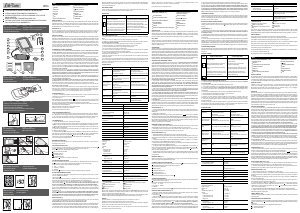


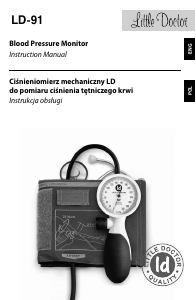
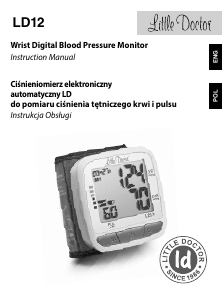
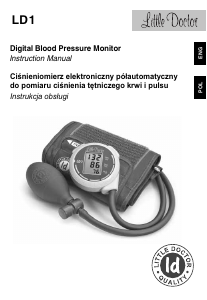
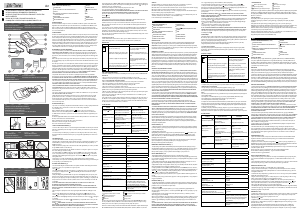
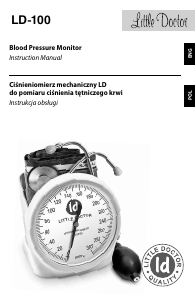
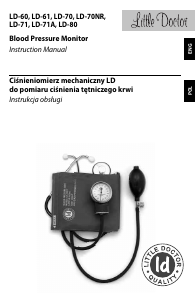
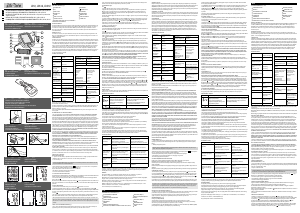
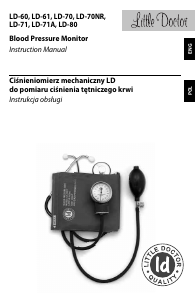
Praat mee over dit product
Laat hier weten wat jij vindt van de Little Doctor LD-51S Bloeddrukmeter. Als je een vraag hebt, lees dan eerst zorgvuldig de handleiding door. Een handleiding aanvragen kan via ons contactformulier.